Author: Keyrock; Compiler: Felix, PANews
Key Points:
More than $600 million worth of tokens are unlocked every week
90% of unlocks, regardless of size or type, create negative price pressure
The impact on token prices usually begins 30 days before the unlocking event
Larger unlocks lead to larger price drops (2.4x) and increased volatility
Team unlocks trigger the worst crashes (-25%) and irrational sell-offs
Investor unlocks show controlled price performance as they adopt smarter strategies and reduce the impact of unlocking on the market
Ecosystem development unlocks are one of the few factors with a positive impact (average +1.18%)
Introduction
More than $600 million worth of locked tokens are unlocked every week (equivalent to Curve’s market cap). These tokens are typically released at predetermined intervals into the hands of different participants. The size and spacing of these unlocks, the expectations and dates, and who receives them all have an impact on token value and the market.
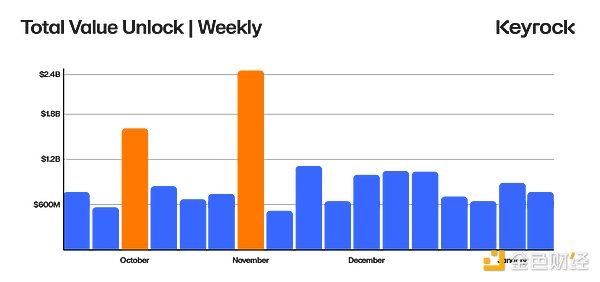
In a crypto space dominated by short-term decision-making and rampant profit-taking, the cadence and structure of token unlocks are critical to ensuring long-term value capture and increasing holder satisfaction. Unlocks are not a novel concept. In traditional finance, mechanisms such as equity vesting have long been used to incentivize employees to stay aligned over the long term. However, in blockchain projects, the methods, frequency, and impact of token unlocks vary widely.
A striking pattern emerged from the 16,000 unlock events analyzed in this article: unlocks of all types, sizes, and recipients almost always have a negative impact on prices.
This article takes a trader-centric approach to examine some of the most prominent token unlocks of the past few years. We analyzed how unlocks of different sizes and recipient types affect price, identifying recurring patterns and key behavioral differences across the ecosystem.
Understanding Unlocks
As a trader, you can’t gain insight into overall retail buy or sell decisions, but you can gain insight into another group of holders: those on the vesting schedule. Unlock schedules are key to unlocking the puzzle, not only do they hint at future supply shocks, but they are also leading indicators of sentiment and volatility.

Most vesting schedules look like the one above: a long-term calendar with “Cliffs” and “Linear or Bulk Unlock Blocks” marked in the middle. These blocks are designated for different recipients — categories like “Seed Investors,” “Core Contributors,” or “Community.”
Designing unlocks is a tricky task for any project. You can’t simply give away all the tokens upfront, because the recipient might leave and sell them. But you can’t make them wait too long, or they might decide the project isn’t worth it. Projects have to strike a balance: incentivize recipients to stay in the early stages of the project while keeping them engaged for the long term. The solution is often to distribute tokens gradually over a specified vesting period.

A typical unlock might look like this: The vesting period starts with the relationship between the recipient and the organization and lasts until all is distributed. For most crypto projects, these are outlined early in the whitepaper. There may be no distributions for the first ⅓ ± ¼ of the vesting period. Then, a large amount of tokens is released all at once, followed by a linear unlock over the remainder of the time.
This approach works because it ensures that recipients make a minimum commitment before receiving their rewards. For example, developers are incentivized to stay involved, while investors face an initial lockup period followed by a partial cashout, and a slow unlock can reduce market pressure.
Not all unlocks follow this structure. Some are called “batch unlocks”, releasing all tokens at the end of the cliffs. Others are purely linear, starting with no cliffs and distributing tokens periodically until they are fully allocated.
Unlock size, a key element of price dynamics
This article first breaks down the vesting period of 16,000 compounding events and categorizes each event by size. For each event, the daily token price is tracked 30 days before and 30 days after the unlock. In addition, the “median” price and volatility metrics are tracked for each token in the month before the 30-day pre-unlock period. This is critical because many projects have a monthly unlock schedule. This method is not perfect, but it can better isolate smaller unlocks.
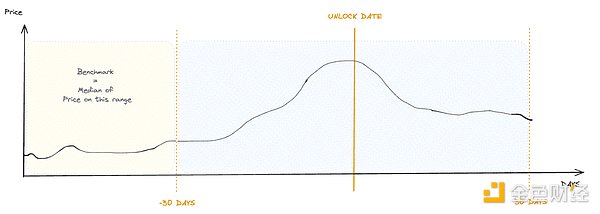
In the end, no asset can exist independently of the market. This is especially true for altcoins, which often exhibit extreme beta correlations with their protocol tokens. To account for this, we normalize the price movement in our data series for each unlock.

For simplicity, we choose ETH as the benchmark and then weight the prices in our sample (before, during, and after the unlock event) with ETH to derive a more market-independent metric.
Unlock Size Isn’t Everything
After breaking down, categorizing, and quantifying the unlock events, we plot the average price impact for different time intervals after the unlock date. When visualized, the data looks messy. You might expect a proportional relationship between unlock size and price impact, but beyond 7 days, the correlation weakens.
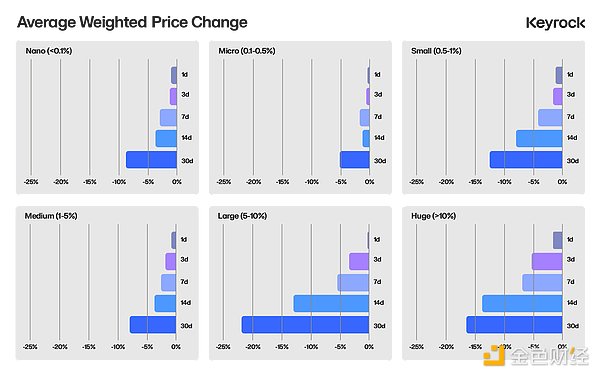
When scaled by relative size, most unlocks look similar in the degree of price suppression they cause. Instead, frequency is the more telling factor. As mentioned earlier, unlocks typically occur in a single large batch after an initial cliff, or occur continuously until the end of the vesting period. For any unlock other than large or huge ones, sustained downward price pressure from smaller, stable unlocks is similarly observed. It is therefore difficult to discern good or bad unlock sizes.
The Cliffs vs. Linearity Divide
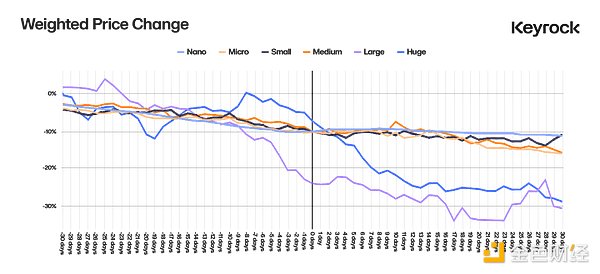
What is clearer in the data is the behavioral characteristics of larger unlocks prior to the event. It is common to see a sustained price decline in the 30 days leading up to the event, accelerating in the final week. After the unlock, prices tend to stabilize and return to neutral levels within about 14 days.
This price behavior can be attributed to two main phenomena:
Complex hedging: Large unlocks are often allocated to hedge recipients using market makers. By locking in prices or taking advantage of volatility before the unlock, these parties reduce token pressure and mitigate the immediate impact of the unlock. Most companies start hedging 1-2 weeks or even a month in advance depending on size. If executed well, this strategy can effectively minimize the impact of the unlock on the market.
Retail anticipation: The sharp decline in the final week may be due to retail investors pushing down prices in advance. They know the unlock is coming and therefore sell tokens to avoid dilution, often unaware that the recipients of the unlock may have already completed the sell-off through hedging.
This behavioral pattern is also evident in the weighted trading volume of different categories, which usually peaks 28 or 14 days before the unlock.
Interestingly, the data shows that huge unlocks (> 10% of supply) perform as well or better than large unlocks (5%–10%). This is likely because the unlocks are too large to be fully hedged and cannot be sold off or unwound within 30 days. Therefore, their market effects tend to be more gradual and long-lasting.
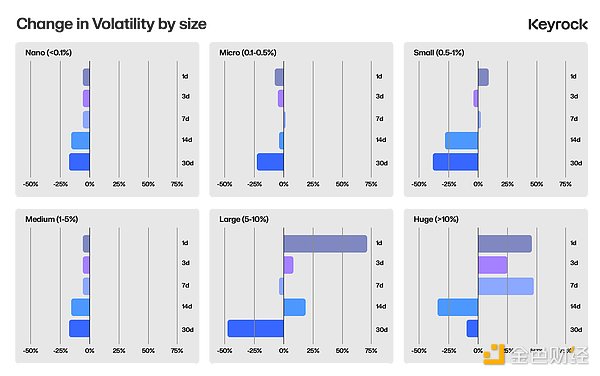
The last chart highlights the change in volatility. Large unlocks cause significant volatility on the first day. However, this volatility largely subsides within 14 days.
How to Trade It?
Most of the time, the key is to pay attention to the very large and large unlocks on the calendar. These are usually the starting cliffs for the transition to linear unlocks. For any given unlock, the proportion of the cliffs awarded can vary widely, ranging from 10% to 50%. What really matters is how much is unlocked relative to total supply.
Data shows that the best time to enter after a major unlock is 14 days later, when volatility has stabilized and hedges may have been unwound. For exits, the best time is 30 days before a major unlock, when hedging or market pre-reactions tend to kick in.
For smaller unlocks, it’s usually best to wait until they’re complete.
Type of recipients, a key predictor of price impact
When analyzing unlocks, the second and most important thing to look at is the type of recipient. Who are the recipients of the tokens, and what does it mean for price action? Recipients can vary widely, but generally fall into five main categories:
Investor unlocks: Tokens allocated to early investors as compensation for funding a project
Team unlocks: Tokens reserved to reward the core team, either through a one-time payment or as wages
Ecosystem development unlocks: Tokens injected into the ecosystem to fund activities such as liquidity, network security, or grants.
Public/Community Unlocks: Tokens distributed to the public via airdrops, user rewards, or staking incentives.
Burn Unlocks: Tokens that are used only for burn, reducing supply. These are rare, so they are not included in this analysis
Opinions vary as to which recipient type has the most impact on downstream prices. Some believe that community airdrops are mostly conducted by Sybil attackers, so the market is flooded with selling pressure. Others believe that injecting millions of tokens into the ecosystem dilutes value. Still others believe that VCs and investors are the ones who sell the fastest and take profits.
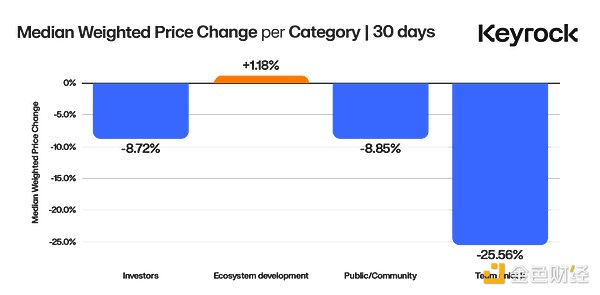
After analyzing thousands of unlock events, the data shows that:
Almost all categories showed a negative price impact, but there were subtle differences
Ecosystem development unlocks were the least disruptive, while team unlocks consistently led to the largest price drops
Investor and public/community unlocks had a moderate impact on price
However, as with unlock size, these numbers alone don’t tell the whole story. Different behaviors emerge when you plot price action by recipient type in the 30 days before and after an unlock event.
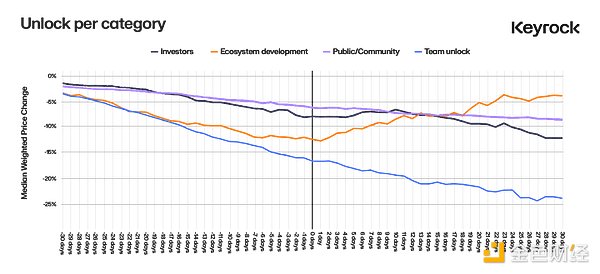
What Drives Taker Behavior?
At first glance, team unlocks appear to be the most disruptive, while ecosystem unlocks pose little threat. But these are only surface level insights. Why is there a difference? What drives taker behavior? What lessons can protocols learn from this data?
Team Unlocks
Team unlocks are one of the most negative categories for price stability. You should be careful when teams are about to hit the Cliffs or are in the middle of a distribution.
When plotted on a graph, the impact on token price follows a roughly linear downward trend, starting 30 days before the unlock date and continuing down at a severe angle. Team unlocks tend to have two characteristics that impact price more than other taker categories.

Uncoordinated sell-offs by team members:
Teams are often composed of multiple players with different financial goals and no coordinated approach to liquidating their tokens
Many team members view their tokens as compensation for long-term (sometimes years) labor before being properly compensated. When these tokens unlock, especially near the Cliffs, the incentive to profit is understandably high
Even with linear unlocks, these tokens are usually part of their revenue and need to be sold
Lack of hedging or mitigation strategies:
Unlike large investors or institutions, teams rarely employ sophisticated techniques to reduce market impact when selling
Sophisticated entities often recruit market makers to strategically manage large token allocations
In addition, pre-hedging strategies can reduce the immediate pressure on the market when unlocking over time.
So these explain why the price was so negative, but why was the price drop also observed in the first 30 days? This is largely likely a combination of severe price impact and overlapping linear unlocks. Why try to control for the median price before observing that many unlocks are consecutive, the data still shows that there is suppression. In this regard, if you do your best, not only skip the bulk Cliffs unlocks, but also postpone purchases during the linear period of unlocking.
Ecosystem Development Unlocks
In terms of ecosystem development, we see a distinct trend: a slight price drop in the first 30 days of unlocking, followed by an immediate positive price impact after unlocking. Unlike other unlock types, ecosystem development unlocks often direct tokens toward initiatives that create long-term value and strengthen the protocol.
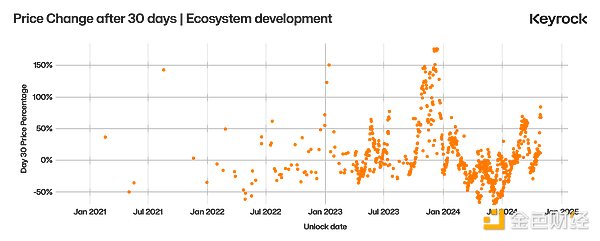
Why Prices Recover (and Often Rise) After Unlocking:
Liquidity Provisioning: Tokens are often allocated to lending platforms or liquidity pools, which increases market depth, reduces slippage, and improves overall token availability. By enhancing “market availability,” these unlocks not only stabilize trading conditions, but also boost confidence among participants
Participation Incentives: Ecosystem funds often drive user participation through incentive programs. These initiatives, such as liquidity mining or staking rewards, create a flywheel effect of participation, which boosts network activity. As participants recognize the potential for continued growth, they are less likely to sell immediately, choosing instead to continue investing in the ecosystem
Grants and Infrastructure Funding: Developer grants and infrastructure project funding support dApp creation and network scalability. While the gains from these investments typically take 6-12 months to realize, they demonstrate a long-term commitment to ecosystem growth, mitigating short-term selling pressure
What explains the price drop before unlocking? There are two reasons for this behavior.
Anti-sell: As mentioned earlier, many investors preemptively sell before unlocking, believing that increasing token supply will dilute value, regardless of the purpose of the unlock. This is particularly common among retail participants, whose misunderstandings about the type of unlock drive short-term decisions.
Liquidity Preparation: Large recipients of grants or allocations often need to prepare liquidity in advance. For example, in order to build a liquidity pool on a DEX, recipients may sell existing assets to secure stablecoins or other paired assets. This preparatory selling creates downward price pressure even before the tokens are deployed.
Investor Unlocks
Investor unlocks are one of the most predictable events in the token market. Unlike other categories, these unlocks typically exhibit controlled price performance, and data from 106 unlock events shows a consistent trend: slow, minimal price declines. This stability is no accident. Early investors (whether angel or C round) often have VC backgrounds and expertise in managing positions.
These investors are not just shifting risk; they are actively avoiding potentially disrupting the market while optimizing returns. By understanding the complex strategies they employ, traders can predict how these events will unfold and adjust their positions accordingly.
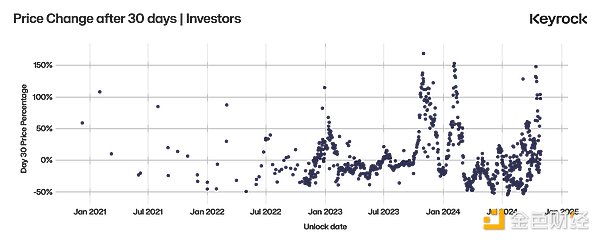
OTC Back Office: Investors often hire liquidity providers or OTC desks to sell large quantities of tokens directly to interested buyers. This approach bypasses the public order book entirely, avoiding immediate pressure from sellers and avoiding sending signals to the market.
T/VWAP and Hedging: Time-weighted average price (TWAP) execution or volume-weighted average price (VWAP) strategies help spread token sales over time, reducing price impact. Many investors also use futures to pre-hedge their positions to "lock in" prices before unlocking events. These positions are then gradually unwound after unlocking to further reduce volatility.
"Locking" or "hedging" is actually using derivatives to open short positions before the unlock date, which helps to guarantee prices early when the short position is unwound at the token sale.
Since 2021, the use of advanced options strategies has expanded beyond investors, with more and more project teams adopting them to generate recurring income or manage funds more efficiently. For traders, this evolution reflects the increasing sophistication of the crypto market, unlocking opportunities to predict and align with the strategies of major players. Options, whether sold privately or used as loan collateral, play a key role in shaping market dynamics, providing informed traders with a clearer perspective to interpret token activity.
Community and public unlocks
Community and public unlocks, such as airdrops and points-based rewards programs, behaviorally mirror investor unlocks, with prices gradually declining before and after the event. This dynamic is shaped by two different behaviors among recipients:
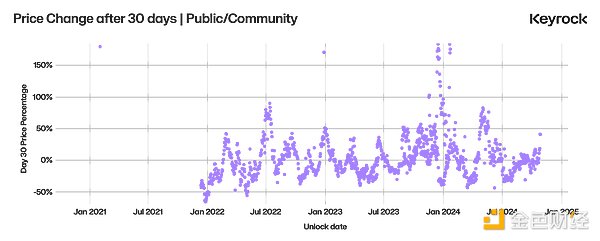
Immediate selling: Many retail participants liquidate rewards as soon as they receive them, prioritizing liquidity.
Long-term holders: Most public airdrops are held rather than sold, reflecting a group of participating users or less active traders.
While the overall price impact was modest, these results highlight the importance of well-designed rewards programs. Thoughtful design can prevent unnecessary market disruption while achieving the intended goal of promoting community development and engagement.
Summary
Token unlocks are an essential mechanism in the crypto ecosystem, used to fund development, incentivize participation, and reward contributors. However, their spacing, size, and recipient class are key factors in determining their price impact. Understanding what these effects are and why they occur can help make better trades and help protocols better structure their unlocks.
This analysis of over 16,000 unlock events across 40 tokens highlights key trends:
Linear unlocks outperform initial cliffs unlocks in reducing short-term price destructiveness, although larger cliffs generally recover better after 30 days.
The most significant price moves often come not from token recipients, but from retail investors reacting to narratives and broader sentiment.
Recipient Class Dynamics
Ecosystem unlocks: Consistently positive results, driving growth through liquidity provision, user incentives, and infrastructure funding.
Investor unlocks: Least disruptive due to complex strategies like OTC sales, TWAP/VWAP executions, and option hedging.
Team unlocks: Most disruptive category, with poor coordination and immature sell-offs leading to significant price drops. Teams can mitigate the impact by working with market makers.
Community unlocks: Limited long-term impact as many recipients hold tokens, but short-term “miners” often sell for immediate gains.
Conclusion
Before committing to a long-term trade, always check the unlock calendar using tools like CryptoRank, Tokonomist, or Coingecko. Unlock events are often misunderstood, but they play a critical role in token performance.
Contrary to popular belief, VC and investor unlocks are not the primary driver of price declines. These players are often aligned with the long-term goals of the protocol, employing strategies that limit market disruptions and maximize returns. In contrast, team unlocks require closer attention as poorly managed allocations often lead to downward pressure on token prices. Ecosystem unlocking presents a unique opportunity that, when aligned with clear growth objectives, often acts as a catalyst for adoption and liquidity, making it an opportune time to enter the market.
 JinseFinance
JinseFinance



















